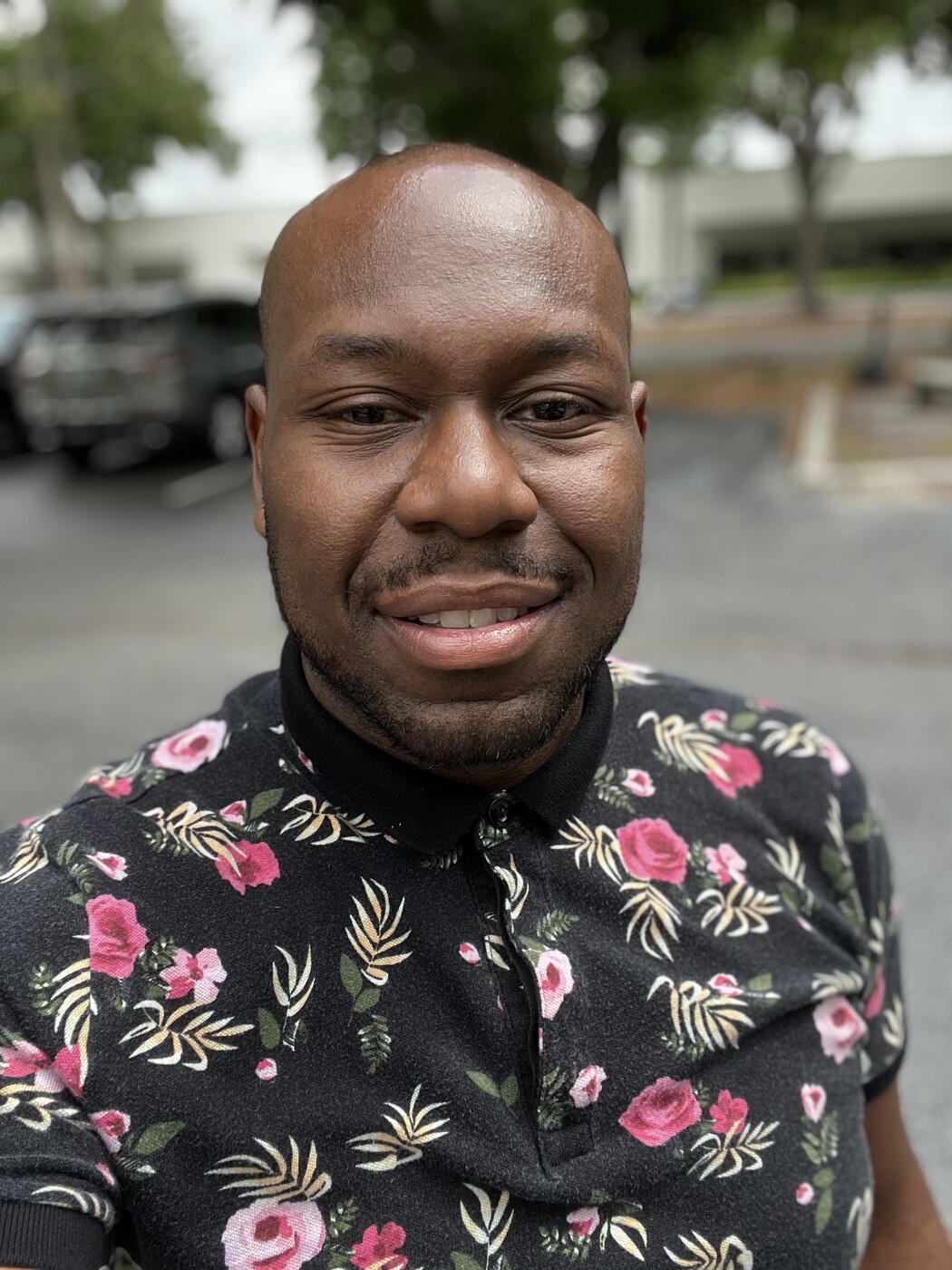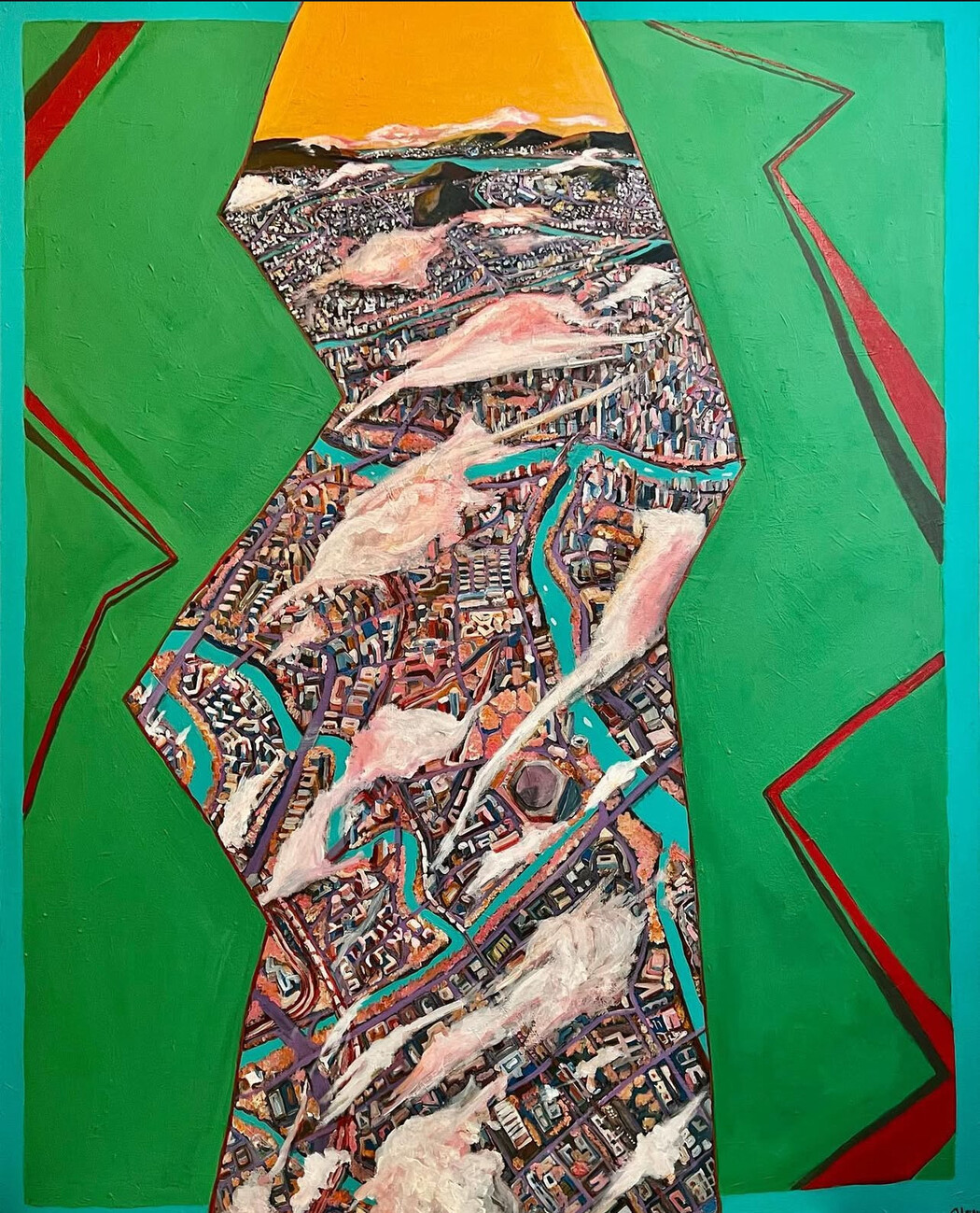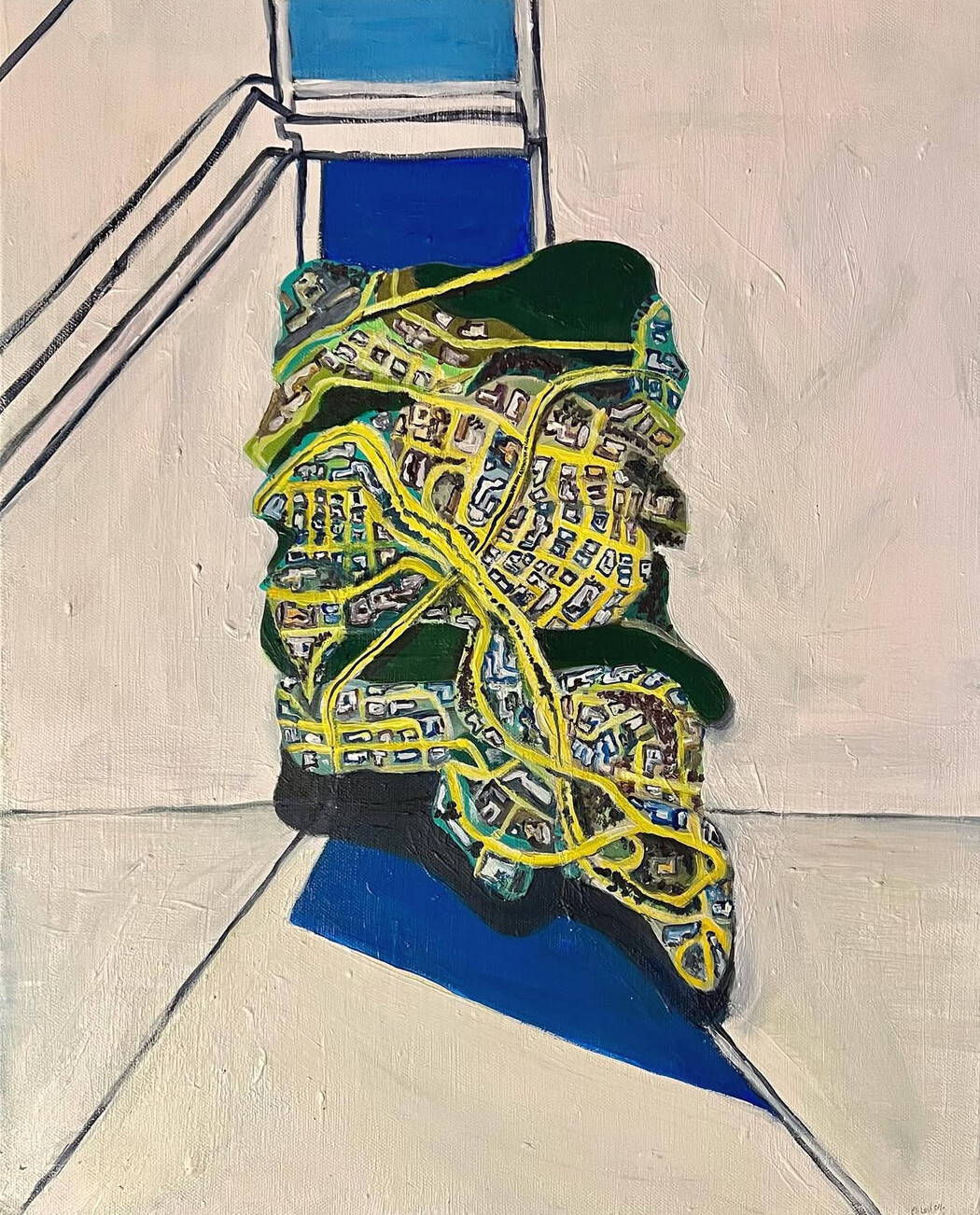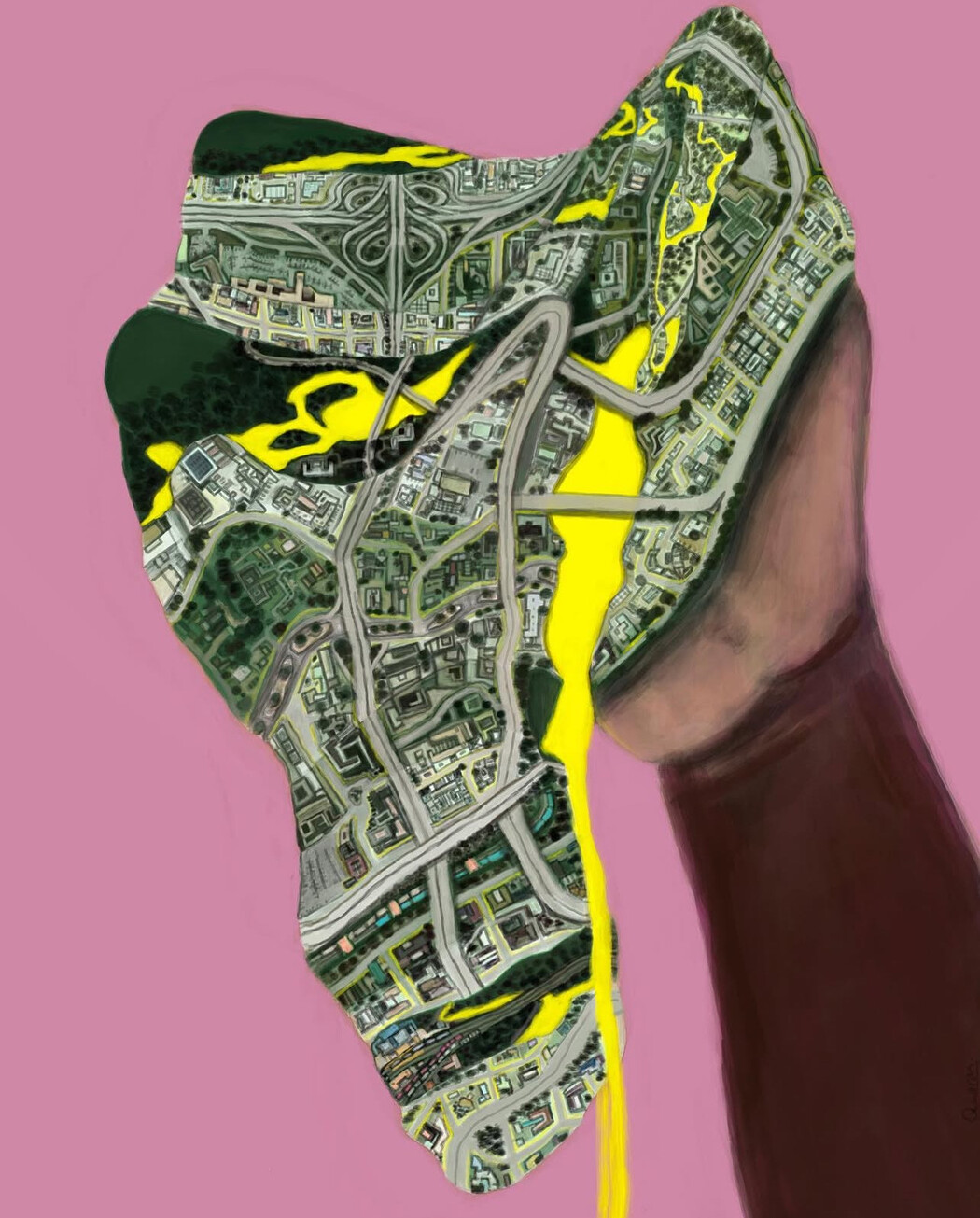Quanel Davis
Year of birth: 1992
Where do you live: Lakeland, FL
Education: B.A. Degree Art History / Business minor
Describe your art in three word: Critical, Innovative, Joyful
Your Discipline: Drawing/Painting/Digital
Website | Instagram

Your work intersection of abstract and landscape art. How did you develop this unique approach to landscape painting?
In retrospect, my exploration ironically began in the middle of my discovery process. In 2016, my interest in abstraction began when I attended the University of South Florida. Our professors encouraged us to have a conceptual approach to art. This definitely resonated with me as I went on my artistic journey. I studied artists’ works from various art movements and styles such as the Renaissance, as well as Impressionism, Abstract Expressionism, Graffiti Art, Modernism and more.
Yet, at the time, I still didn’t know how to create abstract work in my own style. One day, I remembered a taped-together 50-page notebook drawing I made when I was between 14 – 16 years old. The drawing is 5 rows down and 10 columns across — a secret imaginary city I created back around 2006 – 2008. The inspiration came from a movie called “Take the Lead”; one part of the movie had an aerial view of New York City. I wanted to recreate a map or a new city in my own unique way. That specific scene motivated me to pick up my sketchbook and influenced what became my abstract style.
My art contains elements of design, Google map imagery, and random photographic compositions. All of it combined to give each work its own visual clarity. This intersection of landscape and abstract helps breathe life into each piece I create.
Can you tell us about the role of organic and geometric shapes in your pieces and how they influence the viewer’s perception of the landscapes you create?
A universal theme is important in my work. I interpret organic shapes as feminine or natural, and omnipresent. Geometric shapes are seen as masculine or artificial. Historically, landscape paintings have shown mankind’s juxtaposition with the ever-present landscapes of Mother Nature. But utilizing both organic geometric shapes, I can play with new ways to emphasize on form, balance, unity and space. I take photos of random things to build my own reference library of natural and man-made objects. The photos provide me with unending opportunities to combine in new juxtapositions of compositions. My intent is to create work that the viewer perceives as fun, thoughtful, and exciting.
 Quanel Davis | Terraformation Imaging City on Mars | 2023
Quanel Davis | Terraformation Imaging City on Mars | 2023
How do you decide on color palettes you use in your work, and what emotion or conceptual significance do they hold?
The foundation for my color palette originally came from my college professor, who encouraged experimentation and color use based on fabrics and found objects. For a while, I used this as my standard for experimenting with varied color schemes. I used a blend of pastel, complementary, muted color, and tertiary colors. I believe an artist’s choices of color are essential. The appropriate color application guides the viewer into the artist’s world and lets the viewer experience the art in a tactile sense or feel specific emotions. For instance, if I choose to use a monochromatic color scheme instead of pastel, will my intended emotional nuances be lost?
Color can help the viewer navigate through the picture. I’ve learned that if you use complementary colors in specific ways, such as one color being greyed and another one being more pastel, the effect creates a certain vibration. Using colorful linework over wider areas of color on the canvas creates depth. In my work, I use shadows and contrast, which is not usually what most people expect in abstract or semi-abstract work. Finding balance between using shadows and colorful blends gives the paintings an expressive look. Those tiny decisions make a big impact on the viewer’s perception.
You mentioned that your art evokes a sense of familiarity and escapism. How do you balance these aspects with the deeper meanings and abstraction embedded in your pieces?
I feel that those words — familiarity and escapism — resonate with this crazy time period of the 2020’s. There is so much worldly chaos.
We all want to find something familiar that we can escape into. I purposefully make those aspects prevalent and well-balanced in my work. My dental hygienist once called my work “abstract realism”. I found her interpretation to be applicable to my artistic concept.
As for familiarity, I’ve always wanted my work to possess a certain domestic appeal. The viewer should feel the desire to be present in my work. A viewer’s sense of “I’ve seen this before” or “this looks like something” is all a technique of engagement. We have all looked in the clouds to make out what we see in the clouds that connects back to our real world. That visual sense of escaping creates a mental refuge.
Escapism is a more elusive term, which I try to visually and creatively define as evoking more of a feeling for the viewer rather than physical. I’ve learned that titles often dictate the viewer’s overall understanding as to what they should or shouldn’t think of artwork. For example, Terraformation: Imaging City on Mars (2023) commentates for the viewer the work centers on travel and the colonization of Mars. The title explains the artwork, which depicts an image of a congested city with rivers flowing through the martian landscape. Nevertheless, not all titles match with the images displayed within an artist’s artwork. But in my work, I plan for the viewer — and even I — to still experience the allure of wanting to be one with the work.
 Quanel Davis | The Crossing | 2023
Quanel Davis | The Crossing | 2023
Your work has been featured in both private and public spaces, such as murals and commissions. How does the environment or public space influence your creative process?
My main objective is to create artwork for interior spaces such as commercial, private, residential, restaurants, and other business spaces. I believe every business should have a budget for art in their buildings. To me, being commissioned to create artwork for private/public spaces means that people value my artwork. As a child, there were no black artists in my community. Historically, black artists are predominantly portrait artists. To be honest, with me being a black artist that creates abstract art, I was afraid that I would never make money.
In the beginning, I found it scary having to figure out my artistic style with little outside direction. But, of course, with constant work to perfect my concept, I grew into my style, which led to the creation of my portfolio. Once I had a portfolio, I had a range of work to sell. I’ve even created digital design work for my T-shirt brand name called QLaron.
And just like any artist, I want to be compensated for my art after all the years I’ve been creative, consistent, and tenacious in my artistic progress. When I was a University of Southern Florida undergraduate, artist Jake Troyli was in his master’s program. He once told me, ‘ that artist at first have gig with only the exposure. You have to value that as you would a paid gig. With that exposure, you name is out there. get recognition. As you create more art, network, research, and opportunities then the pay will come.’ That day came when I was commissioned to do five paintings over the course of 2021 for the Lakeland Mirrorton apartments. The value in the experience of creating a proposal or a budget for my work is just as important as the price I’ve put on my commissioned work.
Your series often suggests abstract narratives. How do you approach the storytelling aspect of your work, and what do you hope viewers take away from it?
I believe choosing a title for your art sets a theme for your work; the organization of objects and grounds in your work creates a narrative. Landscape alone does not inherently provide a narrative; in most artwork, usually people are the main subject matter. I believe a strong title is an important factor for my narratives. I also like to create two types of variants or different styles — the peculiar variant and suspended variant — in my conception of an art piece to help with narration.
The peculiar variant has normal identifiable aerial imagery, but focuses more on design. For example, my painting Metrosynthesis 22: Hanger Bay (2021) is about a city near a bay going through a storm, but they are holding on to dear life. I chose to embrace similar traditional landscape attributes, such as the placement of the ocean to land in relation to the horizon line. The peculiar part is the flattened landscape distortion; the gray tones, even after the land meets the greenish grey ocean. The water is still exposed under the ground area creating a shortened chaotic feel. In this piece, I incorporated symbols, which I placed at the top of this painting, meaning tender, love, and devotion.
The suspended variant style often has a surrealistic feel to it when I want the viewer to focus more on the artwork’s concept. I purposefully don’t take into account the piece’s horizon line particularly when I want to put more focus on the concept. For example, The Crossing (2023) has a more open narrative but with minimal focus on the ominous background, which consists of a majority of white with some blue tones in the middle. All of it is outlined with black lines. The foreground choice, of placing the map upon this unknown mass of an object, directly challenges the notion of conventional landscape paintings. The linework in the map portion was to portray a congested city over a depleted green natural area. This piece talks about deforestation and overpopulation. Although this painting can be open for multiple interpretations, one interpretation is death to the earth as we cross from one extreme to another. In this suspended environment that could be viewed as purgatory.
 Quanel Davis | Piece of the City | 2022
Quanel Davis | Piece of the City | 2022
As an artist who has exhibited in multiple venues, how has that experience in events like the Lakeland Art Crawl influenced your artistic development?
Overall, Art Crawl has encouraged me and helped me realize my art is marketable.
Exhibiting with them, I’ve learned how to present my artwork in public. Interacting with the public and my fellow artists at Art Crawl, I’ve had opportunities to sharpen my art marketing and networking skills.
My most rewarding Art Crawl experience was winning second place in our call back in 2022. I gained confidence from that recognition of the work I put into my art.
Ultimately here in Lakeland, I aspire to showcase black artists who create conceptual abstract work. I want to encourage the youth that they don’t have to do a portrait or a mural to be considered good artists. As I said earlier, my main focus is to be a catalyst for artistic change in Lakeland.
I want to contact up-and-coming businesses in Central Florida to create artwork for them. I plan to restart QLaron, my shirt design business.
I’d love to do an art residency; I want to travel to find new inspiration. I want to have my work in prestigious art museums throughout the country. As far as my impact in the art world, I want to present something new with my art. I’m truly grateful for the opportunities I’ve had so far.
Life brings you struggles, pain, and, yes,anxiety, but it also brings so much more. Nevertheless, it is truly a blessing to have a talent and gift I’m able to share with the world.

Leave a Reply